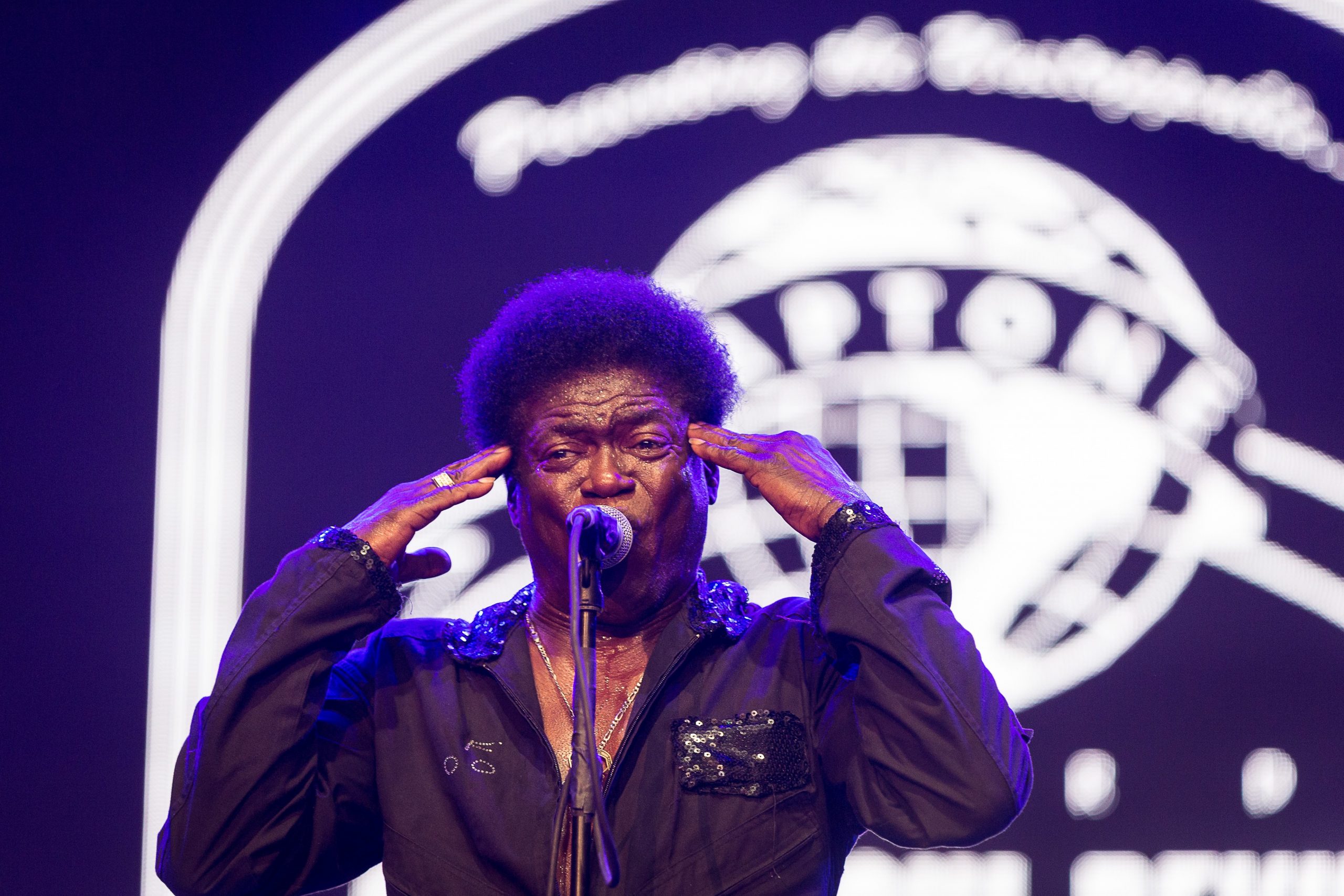When it comes to groups that commercially peaked half a century ago, it's hard to think of one that's more relevant yet easier to take for granted than Sly & The Family Stone.
Imagine if it happened today: a mixed-race, mixed-gender band with a knack for both pop hits and extended funk jams. Imagine if that band were tight enough to satisfy every hip-hop break fanatic and music-school horn section on the planet. Imagine if the band offered an upfront sociopolitical bluntness in the service of both anger and idealism.
Imagine that band today, right? The internet would go nuts. Justifiably.
Sly & The Family Stone were that band even before ARPANET was up and running, which seems like a pretty astonishing detail if you stop to think about it for a moment, though having more than five decades to get used to it -- while also enjoying the works of artists they've influenced, from P-Funk to Prince to The Roots to The Internet -- makes it all seem at least a little less preposterous.
Still, it should at least feel like a big deal that we just hit the 50th anniversary of Stand!, which hit stores back on May 3, 1969 and gave the world seven future pop anthems and a nearly-14-minute funk jam so nasty that James Brown ganked its title. Critics (myself included) swear by the band's star-crossed, long-delayed, undeniably brilliant '71 follow-up There's A Riot Goin' On as their masterpiece, but that record's uncanny blend of beauty and bitterness feels just a bit less remarkable without its blockbuster predecessor to play against.
And it didn't give rise to as many remarkable cover versions as Stand! did, as unlikely and bizarre as some of them are. Here's eight of the best, one for every song on the album.
Woody Herman, "Sex Machine" (1969)
I've heard some of the things Duke Ellington was laying down in the early '70s, so I shouldn't be that surprised when a veteran of the big-band era comes through with something mindblowing well into the rock-soul era. But I can't say I'm not surprised by the idea of bandleader/clarinetist Woody Herman and his band doing an arrangement of the dankest cut in the Family Stone catalog, especially considering it took him until the end of the '60s to even approach breaching the rock-crossover barrier.
The albums he cut for his brief stint on Chess jazz imprint Cadet Records are the big reckonings, and 1969's Heavy Exposure concludes with this brassy, swingin'-with-an-apostrophe version of the Stand! vamp with trumpet solos in place of Sly's vocoder scatting -- though listening to Alan Gauvin's own solo on sax, I wouldn't doubt some mutual appreciation between him and Jerry Martini. The best surprise is the stinging fuzz-blues guitar solo by Phil Upchurch, who was absolutely killing it that year (here's Exhibit A with Muddy Waters), and the transition from his run to Herman taking the last solo on clarinet is the best kind of startling.
Billy Paul, "Everyday People" (1970)
https://youtube.com/watch?v=apL2sAqncgQ
Before was a mainstay of Philadelphia International Records -- where he scored a classic work of infidelity soul in "Me and Mrs. Jones," helmed a cosmic masterpiece in "War Of The Gods," cut a definitive '70s-recession lament in "Let The Dollar Circulate," and made Paul McCartney & Wings' "Let 'Em In" into a civil-rights anthem -- Billy Paul sang jazz. More specifically, he sang soul-jazz, the kind of amped-up turtlenecked-beatnik stuff you could file next to your Eddie Harris & Les McCann records and pull out when you weren't sure whether your party guests preferred bourbon or weed.
Aside from the lightning-strike gospel of his 1968 rendition of Bob Dylan's "Don't Think Twice, It's All Right", his take on "Everyday People" is his biggest worldbeater of a cover pre-PIR: another spirit-feeling call to a secular but righteous congregation with a runaway train of a piano/bass/drum arrangement, and a lead vocal as intensely acrobatic as the original's was beatific. If you had to punctuate the lyrics with an exclamation point each time Paul hit some kind of holy shit-level of intensity in his inflection, a transcript would look like a Dr. Bronner's label. (Oh, also, if you want to cop the album, buy the '73 reissue -- if only because it's the first LP cover Grace Jones' face ever appeared on.)
East Of Underground, "Higher" (1971)
In 1971, the United States Army figured they could use a diversion from the nightmare meat-grinder in Vietnam, and went hey, let's put on a show! The talent contest they set up revealed a couple cover-band winners, and while the winning slot went to a band called SOAP, it was the runner-up group East Of Underground that became an underground cratedigger cause célèbre. While both bands were highlighted on the original release, Wax Poetics reissued East Of Underground's Side B selections as its own LP in 2007, and the band's story has remained the most fascinating thing about them; the musicians were all draftees stationed in West Germany at the time of the album's recording, and they figured they could use the show-band touring opportunity to avoid serving in 'Nam, free and legal.
Their repertoire was filled wall-to-wall funk classics, some of which seem like surprising selections to make it onto an album with the imprimatur of the Armed Forces; they picked a hell of a Curtis Mayfield cut to run through. As for their version of "I Wanna Take You Higher," the fact that they open it with a dual tribute to the TV series The Outer Limitsand the surf-rock instrumental "Out of Limits" hints at a sly sophistication that their nearly invisible post-Army music careers never really got the chance to expand on, and they make up for the absence of a horn section with a manic energy where diabolical laughter and wigged-out adlibs run rampant.
Al Jarreau, "Somebody's Watching You" (1976)
Aside from the proto-Riot anxiety between the song's lines ("The higher the price, the nicer the nice/ Jealous people like to see you bleed"), maybe the most interesting thing about "Somebody's Watching You" is its emphasis on Sly & The Family Stone as a vocal ensemble -- alternating leads and harmonies that showcase every singer in the group. Pare that chorus of voices down to one, and what've you got left for nuance?
Consult Al Jarreau, who if nothing else was frictionless in his delivery, including here. Even if it's kind of a throw-off when he picks the line "shady as a lady in a mustache" to hit that first higher plateau, he's a blast to hear in both the muso-virtuoso and pure-emotion senses (especially in free-association/scatting mode -- "Igotmyeyesonyou!"), and the Crusaders/session-pro musicians finish the picture vividly.
West Street Mob, "Sing A Simple Song" (1982)
If you're a boogie-funk enthusiast, you know them for "Let's Dance (Make Your Body Move)," which peaked at #18 R&B. If you're into old-school hip-hop, you know them for "Break Dance - Electric Boogie," one of the first (but not the first) cuts to sample the Incredible Bongo Band's "Apache." This ... is neither of those.
I don't mean that in a quality-damning sense, though it's kind of an acquired taste to hear an old Sly & The Family Stone classic turned standard-issue electro-funk (especially considering how far-flung Sly's own ideas were getting just a year before). But it makes sense from just the right angle: on Stand! cuts "Don't Call Me N****r, Whitey" and "Sex Machine," Sly became one of the first mainstream popular singers to actually use a vocoder, the instrument that made West Street Mob's singles sound so cutting-edge in the early '80s. Well, one of the instruments, anyways -- the voice modulator on this song sounds more like a talk box. But the spirit's there, even if having it take the place of the horn-section bridge (and turning the melody into the phrase "I love yooooou/ I love you baby") seems a little incongruous.
Ice-T & Jane's Addiction, "Don't Call Me N****r, Whitey" (1991)
This team-up at the first-ever Lollapalooza is the stuff of legends for people of a certain age, a last shambling lap from the about-to-dissolve Jane's Addiction and coming just a year before "Cop Killer" made Ice-T one of the most incendiary and mainstream-loathed figures in music. It starts with a terrible Perry Farrell joke for the Gen-X edgelords in the audience, the apparent catalyst for Ice-T to stride onstage and prove you can give someone a death stare while delivering the song's titular line, and the intensity just boils over from there. The rest of the performance plays off that heightened kayfabe racial animosity, Perry screeching That Slur with an uncomfortable "we all know racism is bad but check out how intensely I can sing this word" delivery as Dave Navarro and Body Count's Ernie C try to shred each other off the stage.
There are some questionable connotations here, not the least of which is the surface appearance of the dueling Black Power/Sieg Heil gestures loosely and implicitly equating black resistance and white supremacy. But the late '80s and early '90s were a far uglier time for racial relations in America than most nostalgists even remember, with hate-crime killings sweeping across the country from Mulugeta Seraw in Portland to Yusef Hawkins in Bensonhurst, not to mention the LAPD brutality in Ice-T's and Jane's Addiction's own home turf. (Lollapalooza '91 came just a few months after the Rodney King beating became worldwide news.) If Farrell and Ice-T doing a deranged tango together was an effort at taking a step to defuse the national mood and offer some hope for reconciliation, at least it's a better attempt than "Black Girlfriend."
Tony! Toni! Toné!, "Stand!" (1995)
https://youtube.com/watch?v=wPCAFoYdsKQ
Of all the reasons to pick up the soundtrack to Mario Van Peebles' '95 Black Panther Party biopic Panther -- including but not limited to two of the most star-studded posse cuts in R&B and rap history -- hearing Oakland's own Tony! Toni! Toné! flash their history-savvy chops in taking on the Bay Area's greatest funkateers is pretty high up there. Turns out it's such a good fit it's almost unremarkable -- one of those oh of course this works listening experiences that's enjoyable but doesn't really surprise you with any new insights into the source material or the band performing it.
The funny thing is that there's one important way this version actually diverges from the original: that famous gospel rave-up that served as the coda, tacked on at the last minute when Sly was worried it wouldn't move the crowd the way he wanted, was played by a group of studio musicians when most of the original band members wound up unavailable to play the supplementary session. So this cover's actually a bit more unified, more or less.
Gabriel Garzón-Montano, "You Can Make It If You Try" (2013)
A simple-enough what-if from an underrated singer-songwriter-producer-composer-multi-instrumentalist: "What if Stand! but Riot?"
Cut a few years before his solo debut Jardín and a couple before Drake yoinked his voice for "Jungle," Garzón-Montano perfectly nails the nuances in Sly's voice as it existed in an exhausted 1971, aching from work and weary over unsettled moodiness but still singing towards his feet as though that's where the sky was. Dial down the tempo a little, make the negative space ring out as deeply as the horns do, and the uplifting closer off a deeply alive album switches the operative exertion from make it to try.






